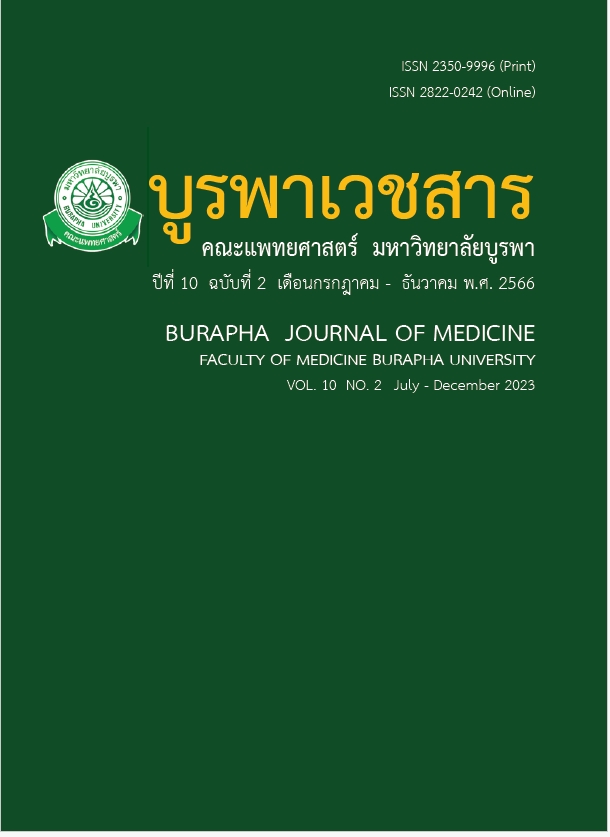ผลของสารสกัดจากเมล็ดกระทงลาย (Celastrus paniculatus Willd.) ต่อการมีชีวิตของเซลล์ ประสาทฮิปโปแคมปัสและซีรีบรัล คอร์เท็กซ์ในหนูแรทเพศผู้
คำสำคัญ:
เมล็ดกระทงลาย , ฮิปโปแคมปัส, ซีรีบรัลคอร์เท็กซ์, อะพอพโทซิสบทคัดย่อ
บทนำ มีการรายงานว่าสารสกัดจากเมล็ดกระทงลายมีฤทธิ์ต้านอนุมูลอิสระ (antioxidant) และยับยั้งการตาย (apoptosis) ของเซลล์เพาะเลี้ยงได้ แต่ยังไม่มีการรายงานถึงผลต่อเซลล์ประสาทในสมองหนูแรท
วัตถุประสงค์ เพื่อศึกษาผลของสารสกัดจากเมล็ดกระทงลายต่อการเปลี่ยนแปลงทางเนื้อเยื่อสมอง รวมถึงฤทธิ์ในการยับยั้งการตายของเซลล์ประสาทผ่านกลไก apoptosis ในหนูแรทเพศผู้สายพันธุ์ Sprague Dawley
วิธีการศึกษา เป็นการศึกษาไปข้างหน้าแบบส่มุ และมีกล่มุ ควบคุมในหนูแรทอายุ 4 สัปดาห์ เพศผู้ จำนวน 12 ตัว หนูแรทกลุ่มทดลอง 6 ตัว ได้รับการฉีดสารสกัดจากเมล็ดกระทงลาย ขนาด 80 มก./กก. น้ำหนักตัว เข้าทางช่องท้องติดต่อกันทุกวันเป็นเวลา 2 สัปดาห์ และกลุ่มควบคุม 6 ตัว ได้รับการฉีดด้วย Dimethylsulfoxide (DMSO) ร้อยละ 0.5 ปริมาตร 0.2 มล. ทุกวันเป็นเวลา 2 สัปดาห์เช่นกัน พักหนูแรท 5 วันก่อนนำไปศึกษาเซลล์ประสาทฮิปโปแคมปัสด้วยวิธีย้อมสี hematoxylin และ eosin ศึกษาการแสดงออกของ anti-apoptotic
protein ชนิด BCL-2 ในซีรีบรัลคอร์เท็กซ์และฮิปโปแคมปัส ด้วยวิธี immunohistochemistry และศึกษาสัดส่วนการแสดงออกของ anti-apoptotic protein (BCL-2) และ pro-apoptotic protein (BAX) ซึ่งเป็นตัวกกำหนดสำคัญในการมีชีวิตรอดของเซลล์ประสาท ด้วยวิธี Western blot จากสมองทั้งลูก (whole brain) นอกจากนี้ ยังทำการบันทึกปริมาณอาหารและน้ำที่กิน และน้ำหนักหนู ตลอดการทดลอง
ผลการศึกษา หนูแรทที่ได้รับสารสกัดจากเมล็ดกระทงลายเป็นเวลา 2 สัปดาห์ ไม่มีผลเปลี่ยนแปลงน้ำหนักปริมาณน้ำและอาหารที่กินในแต่ละวัน แสดงว่าการได้รับสารสกัดจากเมล็ดกระทงลายไม่มีผลกระทบต่อการเจริญเติบโตของร่างกาย หนูแรทกลุ่มทดลองมีลักษณะการจัดเรียงตัวของเซลล์ประสาทภายในฮิปโปแคมปัสไม่แตกแต่งจากกลุ่มควบคุม เป็นไปได้ว่าสารสกัดจากเมล็ดกระทงลายไม่พบความเป็นพิษต่อเซลล์ประสาท และเมื่อศึกษากลไกการยับยั้งการตายของเซลล์ประสาทผ่านการแสดงออกของ BCL-2 ซึ่งเป็น anti-apoptotic protein และ BAX ซึ่งเป็น pro-apoptotic protein พบว่ากลุ่มทดลองมีการแสดงออกของ BCL-2 เพิ่มขึ้นทั้งในซีรีบรัลคอร์เท็กซ์และฮิปโปแคมปัส และเมื่อศึกษาสัดส่วนการแสดงออกของ BCL-2 ต่อ BAX พบว่าเพิ่มขึ้นในกลุ่มทดลองอย่างมีนัยสำคัญทางสถิติเมื่อเทียบกับกลุ่มควบคุม ดังนั้นสารสกัดจากเมล็ดกระทงลายควบคุมสัดส่วนการแสดงออกของ BCL-2 ต่อ BAX จึงอาจจะมีบทบาทสำคัญต่อการปกป้องเซลล์ประสาท
สรุป การศึกษานี้บ่งชี้ว่าสารสกัดจากเมล็ดกระทงลายไม่พบความเป็นพิษต่อเซลล์ประสาทและยังส่งเสริมการมีชีวิตของเซลล์ด้วยการยังยั้งการเกิด apoptosis
เอกสารอ้างอิง
นิจศิริ เรืองรังษี, ธวัชชัย มังคละคุปต์ “กระทงลาย (Krathong Lai)” หนังสือสมุนไพรไทย เล่ม 1. หน้า 27.
Vaidyaratnam PSV. Indian Medicinal Plants: a compendium of 500 species, Vol. 2, Orient Longman Ltd., Anna Salai, Madras, India, 1994; 2: 47–51.
Bhakuni DS, Dhar ML, Dhar MM, Dhawan BN, Mehrotra BN. Screening of Indian plants for biological activity. II Indian J Exp Biol. 1969; 7: 250–62.
Patel RP, Trivedi BM. The in vitro antibacterial activity of some medicinal oils. Indian J Med Res. 1962; 50: 218–22.
Ahmad F, Khan RA, Rasheed S. Preliminary screening of methanolic extracts of Celastrus paniculatus and Tecomella undulata for analgesic and anti-inflammatory activities. J Ethnopharmacol. 1994; 42: 193–8.
Bhagya V, Christofer T, Rao BSS. Neuroprotective effect of Celastrus paniculatus on chronic stress-induced cognitive impairment. Indian J Pharmacol. 2016; 48: 687–93.
Karanth KS, Padma TK, Gunasundari MN. Influence of Celastrus oil on learning and memory. Arogya (Manipal). 1981; 7: 83–86.
Nalini K, Aroor AR, Kumar Rao A. Studies on biogenic amines and their metabolites in mentally retarded children on Celastrus oil therapy. Alternat Med. 1986; 1: 355–60.
Kumar MHV, Gupta YK. Antioxidant property of Celastrus paniculatus willd.: a possible mechanism in enhancing cognition. Phytomedicine. 2002; 9: 302–11.
Bhanumathy M, Harish MS, Shivaprasad HN, Sushma G. Nootropic activity of Celastrus paniculatus seed. Pharm Biol. 2010; 48: 324–7.
Kumar KH, Venuprasad MP, Jayashree GV, Rachitha P, Krupashree K, Pal A, Khanum F. Celastrus paniculatus Willd. mitigates t-BHP induced oxidative and apoptotic damage in C2C12 murine muscle cells. Cytotechnology. 2015; 67: 955–67.
Motoyama N, Wang F, Roth KA, Sawa H, Nakayama K, Nakayama K et al. Massive cell death of immature hematopoietic cells and neurons in Bcl-x-deficient mice. Science. 1995; 267: 1506–10.
Shindler KS, Latham CB, Roth KA. Bax deficiency prevents the increased cell death of immature neurons in bcl-x-deficient mice. J Neurosci. 1997; 17: 3112–9.
Kharbanda S, Pandey P, Schofield L, Israels S, Roncinske R, Yoshida K, Bharti A, Yuan ZM, Saxena S, Weichselbaum R, Nalin C, Kufe D. Role for Bcl-xL as an inhibitor of cytosolic cytochrome C accumulation in DNA damage-induced apoptosis. Proc Natl Acad Sci U S A. 1997; 94: 6939–42.
Peña-Blanco A, García-Sáez AJ. Bax, Bak and beyond - mitochondrial performance in apoptosis. FEBS J. 2018; 285: 416–31.
Gautier F, Guillemin Y, Cartron PF, Gallenne T, Cauquil N, Le Diguarher T, Casara P, Vallette FM, Manon S, Hickman JA, Geneste O, Juin P. Bax activation by engagement with, then release from, the BH3 binding site of Bcl-xL. Mol Cell Biol. 2011; 31: 832–44.
Mao W, Yi X, Qin J, Tian M, Jin G. CXCL12 inhibits cortical neuron apoptosis by increasing the ratio of Bcl-2/Bax after traumatic brain injury. Int J Neurosci. 2014; 124: 281–90.
Bang S, Baek JY, Kim GJ, Kim J, Kim S, Deyrup ST, Choi H, Kang KS, Shim SH. Azaphilones from an Endophytic Penicillium sp. Prevent Neuronal Cell Death via Inhibition of MAPKs and Reduction of Bax/Bcl-2 Ratio. J Nat Prod. 2021; 84: 2226–37.
Ke D, Yu Y, Li C, Han J, Xu J. Phosphorylation of BCL2 at the Ser70 site mediates RANKL-induced osteoclast precursor autophagy and osteoclastogenesis. Mol Med. 2022; 28: 22.
Cheung ZH, Gong K, Ip NY. Cyclin-dependent kinase 5 supports neuronal survival through phosphorylation of Bcl-2. J Neurosci. 2008; 28: 4872–7.
Arora N, Pandey-Rai S. GC–MS analysis of the essential oil of Celastrus paniculatus Willd. seeds and antioxidant, anti-inflammatory study of its various solvent extracts. Industrial crops and products. 2014; 61: 345–51.
Arya A, Kaushik D, Almeer R, Bungau SG, Sayed AA, Abdel-Daim MM, Bhatia S, Mittal V. Application of Green Technologies in Design-Based Extraction of Celastrus paniculatus (Jyotishmati) Seeds, SEM, GC-MS Analysis, and Evaluation for Memory Enhancing Potential. Front Nutr. 2022; 9: 871183.
Borbone N, Borrelli F, Montesano D, Izzo AA, Marino SD, Capasso R, Zollo F. Identification of a new sesquiterpene polyol ester from Celastrus paniculatus. Planta Med. 2007; 73: 792–4.
Malik J, Karan M, Dogra R. Ameliorating effect of Celastrus paniculatus standardized extract and its fractions on 3-nitropropionic acid induced neuronal damage in rats: possible antioxidant mechanism. Pharm Biol. 2017; 55: 980-90.
Kelava T, Avar I, Clulo F. Biological actions of drug solvents. Periodicum Biologorum. 2011; 3: 311–20.
Chintha V, Wudayagiri R. Isolation and neuroprotective prospective of novel bioactive compound “3-(3,4-dimethoxyphenyl)-1-(4-methoxyphenyl) prop-2-en-1-one” against ketamine-induced cognitive deficits in schizophrenia: an experimental study. Natural Product Research. 2021; 36: 1-6
ดาวน์โหลด
เผยแพร่แล้ว
รูปแบบการอ้างอิง
ฉบับ
ประเภทบทความ
สัญญาอนุญาต
ลิขสิทธิ์ (c) 2023 Burapha University

อนุญาตภายใต้เงื่อนไข Creative Commons Attribution-NonCommercial-NoDerivatives 4.0 International License.



